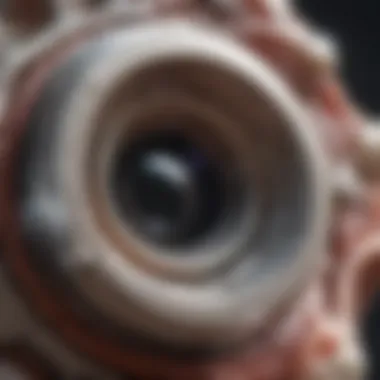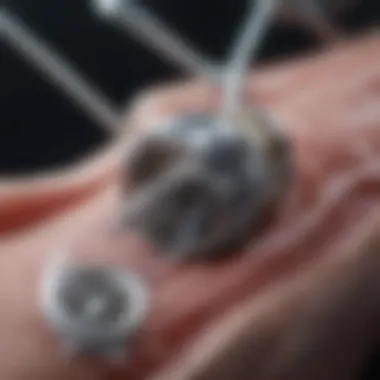Understanding Osseointegration: Mechanisms & Applications


Intro
Osseointegration is essential for the success of implants in medical practices. This process facilitates the direct attachment of bone to the surface of an implant. A proper understanding of osseointegration is critical for students, researchers, and medical professionals. Various factors influence this biological mechanism, from cellular activities to biochemical pathways. The significance of studying osseointegration spans several disciplines, especially in dentistry and orthopedics. It not only improves clinical outcomes but also informs methods to advance implant technology. This article delves into these aspects.
Research Overview
Summary of Key Findings
Osseointegration involves complex biological processes. Key findings include:
- The role of osteoblasts in bone formation.
- The influence of surface characteristics of implants on integration.
- Biochemical signaling pathways that promote osseointegration.
- The effect of mechanical loading on the integration process.
Understanding these findings allows for better design and application of implants, ensuring more successful patient outcomes.
Relevance to Current Scientific Discussions
Current discussions in the scientific community focus on the advances in materials used for implants. Biocompatible materials are at the forefront, contributing to enhanced osseointegration. Researchers are also examining the genetic and environmental factors impacting the osseointegration process. This reflects a shift towards personalized medicine, where treatment is tailored to individual patient needs.
Mechanisms of Osseointegration
At a biological level, osseointegration includes several phases:
- Bone formation preparation: This phase involves the recruitment of bone cells to the implant surface.
- Bone remodeling: Osteoblasts and osteoclasts work together to adapt bone structure to loads and stresses.
- Maturation of interface: The final integration is established through a mature bone-implant interface.
Each phase is crucial and has specific biochemical markers, making it essential to investigate further.
Applications in Medicine
Osseointegration has significant applications in various fields, particularly in:
- Dentistry: Dental implants benefit greatly from osseointegration, making procedures such as endosseous implants successful.
- Orthopedics: Joint replacements rely on effective osseointegration to restore mobility and function.
Advancements in implant technology continuously enhance these applications.
Culmination
Osseointegration is a fascinating topic that continues to evolve. Understanding its mechanisms opens the door to improved outcomes in medical practice. As technology advances, so will our approach to implants, benefiting patients worldwide. This exploration of osseointegration emphasizes the importance of ongoing research and innovation.
Foreword to Osseointegration
Osseointegration is a crucial concept within the realm of implantology, forming the basis for the successful integration of various implants, particularly in dental and orthopedic applications. Understanding osseointegration is vital for several reasons. Firstly, it elucidates how implants bond with bone tissue, significantly impacting the efficacy and longevity of these medical devices. This understanding can guide the development of new and improved materials and techniques in surgery.
Definition of Osseointegration
Osseointegration refers to the direct structural and functional connection between living bone and the surface of an implant. This relationship allows the implant to function as a stable anchor within the bone, which is essential for its purpose. While implants can be made from different materials, typically metals like titanium, their success hinges on a biological process where the bone cells interact positively with the implant surface, allowing for the formation of a stable interface.
Historical Context and Development
The history of osseointegration dates back to the mid-20th century, with pivotal research led by Dr. Per-Ingvar Brånemark. His discoveries on the healing of bone around titanium structures laid the groundwork for the use of dental implants. Initially met with skepticism, the concept evolved through rigorous clinical trials and advancements in surgical practices. Over time, osseointegration has expanded its applicability beyond dentistry into areas such as orthopedic implants and craniofacial surgeries. Its development reflects an intersection of surgical techniques, material science, and biological understanding, highlighting its importance in modern medical practices.


Biological Mechanisms of Osseointegration
Understanding the biological mechanisms of osseointegration is essential for various applications ranging from dental implants to orthopedic interventions. This process is the biological basis upon which implant success relies. Recognizing how the body interacts with implants informs the design of better materials and techniques, ultimately enhancing patient outcomes. The following subsections delve into key processes, cellular interactions, and factors involved in osseointegration.
Bone Healing and Remodeling Processes
Bone healing and remodeling are complex processes that occur after an implant is placed into the bone. Initially, the inflammatory response is triggered, leading to increased blood flow and the recruitment of repair cells to the site of implantation. Over time, this response transforms into a regenerative process where bone mass is restored.
The remodeling phase is characterized by the continual turnover of bone tissue. It involves osteoblasts, which form new bone, and osteoclasts, which resorb old, damaged bone. This dynamic activity ensures that the bone adapts to the mechanical demands imposed by the implant. Understanding these phases helps predict how integration will occur based on various clinical scenarios and conditions.
Cellular Interactions Involved in Osseointegration
Cellular interactions are pivotal in establishing a strong bond between bone and implant surfaces. Various cell types, including osteoblasts and mesenchymal stem cells, communicate through signaling pathways and release growth factors. These factors promote cell migration, proliferation, and differentiation at the implant interface.
Research indicates that both intrinsic and extrinsic factors influence these cellular responses. Surface modifications on implants can enhance or inhibit cellular activity. Additionally, the surrounding biological environment—composed of cells, tissue, and cytokines—significantly impacts the rate and quality of osseointegration.
Role of Osteoblasts and Osteoclasts
Osteoblasts and osteoclasts play critical roles in the process of osseointegration. Osteoblasts are responsible for new bone formation, originating from mesenchymal stem cells. They create the bone matrix and initiate mineralization. In contrast, osteoclasts are involved in bone resorption, modulating the bone’s structure to accommodate new loads or mechanical stress.
The balance between osteoblast and osteoclast activity is integral for optimal osseointegration. An overactive osteoclast function can lead to compromised integration, while robust osteoblast activity leads to successful bone formation around the implant. Therefore, understanding their interaction is essential in furthering clinical success.
Matrix Formation and Mineralization
Matrix formation and mineralization are foundational for osseointegration. Initially, a provisional matrix forms around the implant due to the action of osteoblasts. Subsequently, this matrix undergoes mineralization, mainly driven by calcium and phosphate deposits that give bone its rigidity.
The properties of the matrix influence the overall strength and stability of the resulting osseointegration. Various factors, such as the mechanical environment and biochemical signals, can influence matrix composition and integrity. Enhanced matrix formation supports better load distribution, reducing the chances of implant failure.
Factors Influencing Osseointegration
Osseointegration is a complex process. Several factors can influence how well an implant integrates into the bone. Understanding these factors is crucial for both clinicians and researchers. The success of osseointegration directly impacts patient outcomes, implant longevity, and overall functionality. A deeper insight into these factors will guide better practices in implantology.
Implant Material and Surface Properties
The materials used in surgical implants play a pivotal role in osseointegration. Titanium, one of the most commonly used materials, is favored for its biocompatibility and mechanical strength. However, even within the realm of titanium, different surface treatments can significantly affect integration.
Surface roughness enhances the contact area between the implant and the bone, promoting better adhesion. For example, sandblasting and acid etching create a rough surface that facilitates cellular attachment. Other coatings, like hydroxyapatite, can further encourage mineralization and foster osseointegration.
The interaction between the implant's surface properties and bone tissue must not be underestimated. The right material and surface treatment can lead to quicker integration times and better stability.
Mechanical Load and Stability
Mechanical factors can also influence osseointegration remarkably. When an implant is placed, it must withstand various forces. If the load placed on the implant exceeds its stability, failure can occur. Stability is essential immediately post-surgery to ensure the process can begin without complications.
The right balance of load during the healing phase helps maintain stability. Too much load can lead to micromovement, disrupting the healing process and delaying osseointegration. Therefore, understanding the loads and forces during activities is essential for clinicians managing patient rehabilitation.
Local Biological Environment
The local environment surrounding the implant significantly affects osseointegration. The availability of nutrients and oxygen is crucial for healing. Factors like vascularization ensure that the implant site receives sufficient blood flow. Poor blood flow can lead to a lack of healing and increased risk of failure.


Additionally, the presence of growth factors within the local environment promotes cellular activity. These factors can accelerate healing and enhance osseointegration if they are available in sufficient quantities. Conditions such as infection, inflammation, or foreign body responses can strongly influence the biological environment and subsequently the success of osseointegration.
Systemic Health Conditions Impacting Osseointegration
Overall health conditions play a vital role in osseointegration. Conditions like diabetes may impede healing processes, resulting in slower integration rates. Similarly, osteoporosis can weaken bone quality, making it harder for implants to achieve adequate stability.
Patients on medications like corticosteroids might face additional challenges, as these can impact bone metabolism and healing. Thorough preoperative assessments are crucial to identify and manage these systemic conditions effectively. By understanding these health-related factors, healthcare providers can tailor their approaches to optimize osseointegration.
"The successful integration of an implant depends not only on the surgical technique but also on material properties, local conditions, and systemic factors."
In summary, understanding the multifaceted factors influencing osseointegration can help enhance clinical practices. When the right considerations are taken into account, the overall success of implants can be maximized, benefiting both patients and healthcare providers.
Applications of Osseointegration
The applications of osseointegration hold significant importance in medical fields, particularly in dentistry and orthopedics. The successful integration of implants into bone tissue facilitates various procedures, improves patient outcomes, and enhances quality of life. Understanding these applications helps to clarify how osseointegration benefits both clinicians and patients.
Osseointegration in Dentistry
Dental Implants
Dental implants represent one of the most significant advancements in restorative dentistry. The specific aspect of dental implants that sets them apart is their ability to replicate the function of natural teeth by integrating with the jawbone. This integration provides a stable foundation for prosthetic teeth. The key characteristic of dental implants is their structure, which resembles a tooth root, allowing for effective load distribution and preventing bone resorption. This makes dental implants a popular choice for patients who seek not only cosmetic restoration but also functionality comparable to natural teeth.
The unique feature of dental implants is the titanium used in their construction. Titanium is biocompatible and promotes osseointegration, enhancing stability. The advantages of dental implants include improved chewing ability, preservation of jawbone structure, and durability. However, they also present disadvantages, such as the need for surgical procedures and the potential for complications if the implant does not properly integrate.
Bone Grafting Techniques
Bone grafting techniques play a crucial role in enhancing osseointegration. These procedures are often necessary when there is inadequate bone volume in the jaw for successful implant placement. The specific aspect of bone grafting is its ability to provide the necessary substrate for new bone formation, promoting better implant stability. Bone grafting is a beneficial choice for patients with serious bone loss.
A key characteristic of bone grafting techniques is the use of various graft materials, including autografts, allografts, and synthetic materials. Each type has its own advantages and disadvantages. Autografts, taken from the patient’s body, tend to create less risk of rejection. However, they require a second surgical site. Allografts and synthetic materials offer more immediate availability but could have longer healing times. The unique feature of these techniques is their ability to prepare the site for osseointegration, ensuring a solid foundation for dental implants.
Osseointegration in Orthopedics
Joint Replacement Procedures
In orthopedics, joint replacement procedures heavily rely on osseointegration. This process is vital for the stability and longevity of artificial joints. The specific aspect of these procedures involves replacing damaged joints with prosthetics that integrate within the bone. This integration allows patients to regain mobility and reduces pain associated with joint diseases.
A key characteristic of joint replacement is the design of prosthetic elements, which aims to mimic the natural joint anatomy. With modern materials, these implants achieve high levels of osseointegration, making them more effective and durable. The advantage of joint replacement procedures lies in the significant improvement in the patient’s quality of life. However, complications such as implant loosening can occur if osseointegration fails.
Fracture Fixation Systems
Fracture fixation systems utilize osseointegration to stabilize broken bones. The specific aspect of these systems is their ability to securely hold fractured bone ends together while promoting healing. These devices, such as plates, screws, and rods, directly interact with the bone, facilitating effective osseointegration.
A key characteristic of fracture fixation systems is their versatility; they can be tailored to various fracture types and locations. The unique advantage of these systems is their capacity to provide stability during the healing process, which can lead to faster recovery times. However, potential disadvantages include risks associated with surgical placements and delayed healing in some patients.
Innovations in Prosthetics
Innovations in prosthetics have greatly enhanced the field of osseointegration. With advances in materials science and biomedical engineering, new prosthetic designs are being developed to improve the bond between implants and bone. This ongoing research aims to optimize the integration process and offer more personalized solutions for patients. An important aspect of these innovations is the development of smart implants that can potentially monitor healing and adapt to the body's needs. The future of prosthetics will likely see further enhancements that leverage osseointegration, improving outcomes and quality of life for users.
Preclinical and Clinical Studies on Osseointegration


The significance of preclinical and clinical studies in osseointegration cannot be overstated. These studies serve as the backbone for understanding how implants interact with bone tissue. They provide vital insights into the biological responses that occur during the implantation process. Moreover, this research helps to identify factors that enhance or hinder successful osseointegration. Thus, these studies play a crucial role in improving patient outcomes and advancing implant technology.
Current Research Trends
Recent trends in osseointegration research include a focus on surface modifications of implant materials. For example, researchers are exploring coatings that promote faster integration with surrounding bone. Nanostructured surfaces are also of interest, as they can improve cellular responses. Additionally, studies are looking at bioactive glasses and regenerative medicine techniques. These advancements aim to enhance the biological interactions at the implant site, ultimately improving success rates.
Furthermore, researchers are employing various imaging techniques to monitor osseointegration in real-time. This includes using micro-computed tomography to track bone growth around implants. Such innovative methods provide precise data, helping to refine current protocols in both preclinical and clinical settings.
In terms of methodologies, the use of animal models remains critical. These models allow researchers to assess the osseointegration process over time. Findings can then inform clinical trials, where factors such as patient health, types of implants, and surgical techniques are further analyzed.
Clinical Outcomes and Success Rates
Clinical outcomes of osseointegration can be quite favorable, underscored by high success rates in various applications. For instance, in dental implants, studies have reported success rates exceeding 90%. This high level of success highlights the effectiveness of current techniques and materials used in implantation.
However, several factors influence these rates. They include patient-specific factors such as age, health status, and lifestyle choices. For example, individuals with diabetes or those who smoke may experience higher complications.
On the other hand, careful selection of implant designs and materials enhances clinical outcomes. Customization of features like implant length and diameter based on specific patient needs aids in optimizing stability and integration.
A notable aspect of clinical studies involves ongoing patient monitoring post-implantation. Assessing osseointegration through periodic evaluations helps identify potential failures early on. This proactive approach ensures better management and keeps success rates high.
"Osseointegration studies not only pave the way for technological advancements but also help in tailoring implant options to individual patient needs."
In summary, preclinical and clinical studies are essential in advancing our understanding of osseointegration. By assessing both biological processes and clinical outcomes, researchers contribute to the development of more effective implants, ultimately benefitting patient care.
Challenges and Limitations of Osseointegration
Osseointegration plays a vital role in implantology, but it comes with its own set of challenges and limitations. Understanding these factors is essential for improving the success rates of osseointegration procedures. Failing to address these challenges can lead to complications such as implant failure or inadequate bone integration.
Failure Factors in Osseointegration
Several reasons may contribute to the failure of osseointegration. Understanding these factors is critical for practitioners and researchers.
- Biological Factors: The body's biological response can impede successful osseointegration. Factors such as poor blood supply, infection, and systemic diseases can compromise healing.
- Implant Design and Material: The choice of implant materials significantly impacts osseointegration. Materials that do not promote suitable biological responses may fail. For instance, titanium is commonly used, but suboptimal surface treatments can limit its effectiveness.
- Mechanical Loading: Excessive or improper loading on the implant can disrupt the healing process. It can lead to micromovements that prevent successful bone apposition.
- Patient-Specific Characteristics: Individual health conditions, like osteoporosis or smoking, can hinder adequate bone formation around implants. Age and overall health are also vital considerations related to osseointegration.
"A nuanced understanding of failure factors can inform better surgical techniques and material choices."
Future Research Directions
Moving forward, research in osseointegration should address its current challenges. This can involve multiple avenues:
- Innovative Materials: Exploring new biomaterials and coatings can enhance osseointegration. Researchers are looking into bioactive glass and polymers that stimulate bone growth.
- Biological Enhancements: There is potential in investigating biological agents such as growth factors and stem cells that may improve healing processes.
- Surface Modifications: Advancing surface treatments to increase roughness and porosity could facilitate better bone integration and stability.
- Longitudinal Studies: More clinical studies with longer follow-up periods could provide deeper insights into the long-term outcomes of osseointegration.
In summary, understanding the challenges and limitations of osseointegration is essential for improving implant-based treatments. Both clinical practices and research can benefit from focusing on these aspects.
Closure
The conclusion of this article outlines the critical aspects of osseointegration and highlights its significance across various fields such as dentistry and orthopedics. Osseointegration is not just a technical term; it is a profound biological phenomenon that ensures the success of implantable devices in human anatomy. Understanding the mechanisms of osseointegration leads to better design and implementation of implants, ultimately improving patient outcomes.
Summary of Key Insights
The exploration of osseointegration identified several key insights:
- Osseointegration is essential for the stability and longevity of implants.
- Key biological processes such as bone remodeling and cellular interactions play a vital role in successful integration.
- Factors like implant material, mechanical load, and the overall biological environment significantly influence osseointegration outcomes.
- Current research on osseointegration indicates ongoing improvements and innovations in both techniques and technologies used in dental and orthopedic procedures.
"Success in osseointegration not only hinges on the materials used but also involves a deep understanding of the biological processes at play."
The Future of Osseointegration
Looking ahead, the future of osseointegration appears promising as research continues to evolve. Future perspectives include:
- Emerging Technologies: Advances in materials science may lead to the development of smarter implants that can enhance osseointegration.
- Personalized Medicine: Tailoring osseointegration techniques to individual patient conditions may increase success rates and minimize complications.
- Bone Regeneration Therapies: Novel approaches such as stem cell therapies and gene editing could significantly enhance the biological healing process.
- Interdisciplinary Research: Collaborations among engineers, biologists, and medical professionals may foster innovative solutions to current challenges in osseointegration.



